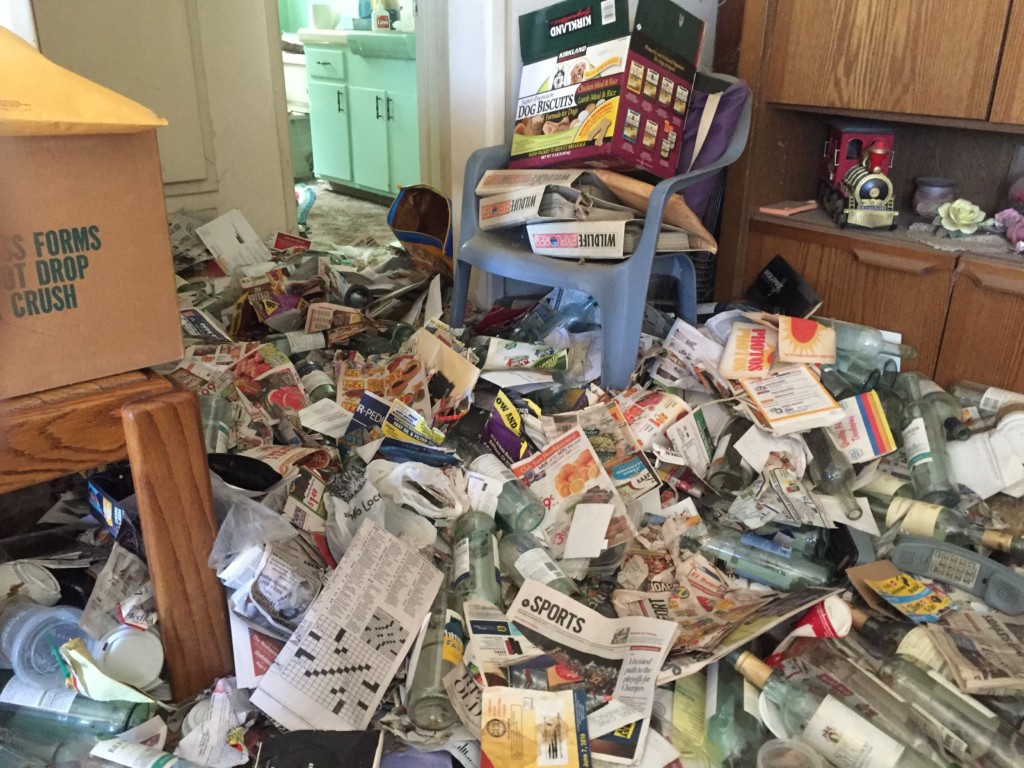How To Identify And Address Bed Bug Infestations In a Hoarding Situation
Mar 06th, 2023

Our friends at Hoarders 911 wrote a comprehensive guide on how to identify and address beg bug infestations in a hoarding situation. You can find the full article HERE.
HOW TO IDENTIFY AND ADDRESS BED BUG INFESTATIONS IN A HOARDING SITUATION
The problem of bed bugs in hoarders’ homes is a serious concern. Hoarding disorder is characterized by an inability to discard or part with possessions, resulting in the accumulation of clutter that can fill living spaces and interfere with everyday activities.
These environments can be difficult to clean and maintain, creating conditions that are ideal for bed bugs to thrive.
Bed bugs are small, parasitic insects that feed on the blood of humans and animals. They are often found in bedding, furniture, and other items commonly found in a cluttered house often associated with hoarding disorder.
Bed bugs can be difficult to detect, as they are small and often hide during the day, coming out at night to feed.
When bed bugs infest hoarding environments, they can pose a number of health risks to individuals living in these spaces.
Bed bugs can cause itchy, red bites, which can lead to secondary infections if scratched. In addition, the psychological toll of living in a cluttered environment with a bed bug infestation can be significant, contributing to stress, anxiety, and other mental health issues.
Treating bed bug infestations in an individual who hoards can be challenging, as the clutter and obstacles present can make it difficult to access and treat all areas where bed bugs may be hiding.
It is important to identify and address bed bug infestations as soon as possible to prevent them from spreading to neighboring homes and causing further problems.
UNDERSTANDING BED BUGS IN A HOARDING SITUATION

This is an important aspect of addressing the problem. Bed bugs are small, reddish-brown insects that are typically about the size of an apple seed. They feed on the blood of humans and animals and can live for several months without a blood meal.
Bed bugs are known for their ability to hide in cracks and crevices, making them difficult to detect and eliminate. They are often found in bedding, furniture, and other items commonly found in a hoarder’s house.
Bed bugs can also be transported on clothing, bags, and other personal belongings, making it easy for them to spread to new locations.
In hoarding environments, the clutter and obstacles present can make it even more difficult to detect and eliminate bed bug infestations.
Bed bugs can hide in piles of clutter and debris, making it challenging to access all areas where they may be present.
Additionally, the presence of bed bugs in a hoarding situation can pose unique challenges for treatment. The clutter and obstacles may make it difficult to move furniture and other items to clean and treat all areas where bed bugs may be present.
Furthermore, individuals with hoarding disorder may have difficulty parting with their possessions, which can complicate the treatment process.
Addressing bed bugs in a hoarding situation requires a thorough understanding of the behavior and biology of these insects, as well as an awareness of the unique challenges posed by cluttered environments.
By working with experienced pest control professionals and mental health experts, it is possible to effectively identify and address bed bug infestations in hoarding environments, improving the health and well-being of those living in these spaces.
HEALTH RISKS AND DANGERS OF HOARDING AND BED BUGS

Hoarding and bed bugs can both pose significant health risks and dangers to individuals living in affected environments.
Hoarding:
- Increased risk of falls and injuries
The presence of clutter and obstacles can increase the risk of falls and injuries, particularly in elderly or disabled individuals. - Respiratory problems
Clutter and debris can contribute to poor indoor air quality, which can lead to respiratory problems such as asthma and allergies. - Fire hazards
Clutter can increase the risk of fire hazards, particularly if flammable materials are present. - Social isolation
Hoarding can lead to social isolation and disconnection from family and friends, which can contribute to poor mental health.
Bed Bugs:
- Itchy, painful bites
Bed bugs can cause itchy, painful bites, which can lead to secondary infections if scratched. - Psychological distress
The presence of bed bugs can contribute to stress, anxiety, and other mental health issues. - Allergic reactions
Some individuals may have allergic reactions to bed bug bites, which can range from mild to severe. - Spread of disease
While bed bugs are not known to transmit diseases, their bites can cause secondary infections that may pose a risk to individuals with weakened immune systems.
The presence of bed bugs in a hoarding environment can exacerbate the health risks associated with hoarding, particularly if individuals are already struggling with physical or mental health issues.
Addressing both hoarding and bed bugs is critical to improving the health and well-being of those living in affected environments.
HOW HOARDING CAN LEAD TO BED BUG INFESTATIONS

Hoarding can lead to bed bug infestations in several ways:
- Clutter provides hiding places for bed bugs The piles of clutter and debris present in a hoarded place provide numerous hiding places for bed bugs. Bed bugs can easily hide in and around clutter, making them difficult to detect and eliminate.
- Obstacles make it difficult to access and treat infested areas
The presence of clutter and obstacles can make it difficult for pest control and hoarding cleaning professionals to access and treat all areas where bed bugs may be present. This can make it harder to eliminate the infestation and may require multiple treatments. - Bed bugs can be transported on personal belongings
Hoarding environments often contain a large amount of personal belongings, such as clothing, bags, and furniture.Bed bugs can easily hitch a ride on these items and be transported to new locations, increasing the risk of infestation in other areas of the house or even in other homes or buildings. - Hoarding can make it harder to maintain cleanliness and hygiene
The clutter and debris can make it harder to maintain cleanliness and hygiene, which can attract bed bugs and other pests.Bed bugs are attracted to areas where humans spend a lot of time, so a cluttered and unsanitary environment can make it more likely that they will infest.
Hoarding can create an environment that is conducive to bed bug infestations. Addressing hoarding behaviors and decluttering the home can help to reduce the risk of bed bugs and other pest infestations, improving the health and well-being of those living in affected environments.
WHERE DO BED BUGS HIDE IN A HOARDERS HOUSE?

Bed bugs can hide in a variety of places in a heavily-cluttered house due to the presence of clutter and obstacles that create numerous hiding places. Here are some common areas where bed bugs may hide in a hoarder’s house:
- Mattresses, box springs, and bedding
Bed bugs are often found in or around the bed, where they can easily access their human hosts. - Furniture
Bed bugs can hide in and around furniture, such as sofas, chairs, and tables, as well as in the upholstery, seams, and crevices. - Clothing and personal belongings
Bed bugs can hitch a ride on clothing and personal belongings, making them difficult to detect and control. - Electronics and appliances
Bed bugs can also hide in and around electronics and appliances, including televisions, computers, and alarm clocks. - Wall and floor cracks
Bed bugs can hide in wall and floor cracks, particularly near the bed or other areas where people spend a lot of time. Read more here: Bed Bugs in Walls: Learn How to Find and Get Rid of Them. - Clutter and debris
Bed bugs can hide in piles of clutter and debris, including stacks of papers, books, and magazines, as well as in cardboard boxes and plastic bags.
These are just a few examples of common hiding places for bed bugs in a hoarder’s house. Bed bugs can hide in many other areas as well, and a thorough inspection by a pest control and hoarding cleaning professional is often necessary to identify all areas where bed bugs may be present.
COMMON SIGNS OF BED BUGS IN A HOARDER’S HOUSE

More often than not, and depending on the level of severity, identifying bed bugs in a heavily cluttered space can be challenging due to the clutter and debris.
Fortunately, there are several common signs of bed bugs that may be visible in a hoarded house that could lead to a sign of infestation:
- Live or dead bed bugs
Adult bed bugs are about the size and shape of an apple seed, and may be visible crawling around or hiding in cracks and crevices. Bed bug eggs and shed skins may also be visible. - Fecal stains
Bed bugs leave small black or brown fecal stains on bedding, furniture, and other surfaces where they feed. - Blood stains
Bed bugs feed on blood and may leave behind small blood stains on bedding, furniture, or clothing. - Musty odor
Bed bugs release a musty, sweet odor, which may be particularly noticeable in areas where infestations are severe. - Bite marks
Bed bugs feed on human blood and leave behind itchy, red bite marks, often in a cluster or line. - Bed bug casings
Bed bugs shed their skin as they grow, leaving behind brown, shell-like casings that may be visible in the creases of mattresses, behind furniture, or in other hiding places. - Presence of bed bug traps
Bed bug traps, which are designed to capture and trap bed bugs, may be visible in and around the hoarding environment.
ESSENTIAL TOOLS USED IN DETECTING BED BUGS IN A HOARDING SITUATION

- Flashlight
A flashlight can be used to illuminate dark corners and crevices where bed bugs may be hiding. - Magnifying glass
A magnifying glass can help to magnify and clarify the appearance of small insects, making it easier to identify whether they are bed bugs or other pests. - Sticky traps
Sticky traps are adhesive-based traps that can be placed in various areas around the house to capture bed bugs. They can be especially effective in areas where bed bugs are likely to travel, such as along baseboards or behind furniture. - Canine scent detection
Specially trained dogs can be used to detect the scent of bed bugs in a hoarder’s house. These bed bug sniffing dogs can be particularly effective in large or cluttered areas where it may be difficult for a human to locate bed bugs.
A thorough inspection by a pest control professional is often necessary to ensure that all areas where bed bugs may be present are identified and treated.
STEPS INVOLVED IN ADDRESSING BED BUG INFESTATIONS RELATED TO HOARDING

Treating bed bug infestations in hoarding situations can be challenging due to the clutter and debris present in the environment. Here are the general steps involved in treating bed bug infestations related to hoarding:
- Inspection
The first step in treating a bed bug infestation in a hoarding situation is to conduct a thorough inspection of the premises. This involves identifying areas where bed bugs are likely to be hiding, such as cracks and crevices in furniture and bedding. For better result, the inspection should be conducted by bed bug extermination professionals. - Pre-treatment preparation
Preparation for treatment is crucial to the success of the treatment. This may involve removing clutter and debris, washing and drying all linens, and vacuuming and cleaning all surfaces. - Treatment optionsDepending on the severity of the infestation, there are several treatment options available. These may include:
- Chemical treatments: Chemical treatments involve the use of pesticides to kill bed bugs. The most common types of pesticides used for bed bug control are pyrethroids and neonicotinoids.These pesticides can be applied as a liquid or dust and are effective in killing bed bugs and their eggs. However, they may require multiple treatments and should be applied by a licensed pest control professional.
- Heat treatments: Heat treatments involve using high temperatures to kill bed bugs. This method can be effective in killing bed bugs and their eggs without the use of chemicals.Heat treatments typically involve heating the room to a temperature of 120 to 135 degrees Fahrenheit for several hours. However, heat treatments can be expensive and may require specialized equipment.
- Steam treatments: Steam treatments involve using high-temperature steam to kill bed bugs and their eggs. This method can be effective in treating small areas and is often used in combination with other treatment methods.
- Vacuuming: Vacuuming can be an effective method for removing bed bugs and their eggs from furniture, carpets, and other surfaces. However, vacuuming alone may not be enough to eliminate a bed bug infestation.
- Freezing: Freezing involves exposing bed bugs and their eggs to low temperatures to kill them. This method can be effective for treating items such as clothing, bedding, and small items that can be placed in a freezer.
- Post-treatment follow-up
Once the treatment has been completed, it is important to follow up to ensure that all bed bugs have been eliminated. This may involve additional treatments or monitoring of the premises to detect any signs of bed bugs. - Preventive measures
Preventive measures are crucial in preventing future bed bug infestations in hoarding environments. This may involve regular cleaning and vacuuming, maintaining a clutter-free environment, and monitoring for any signs of bed bugs. - Ongoing support
It is important to provide ongoing support to the hoarder to address the underlying cause of the hoarding behavior. This may involve seeking the help of a mental health professional or support group.
ARE BED BUG SPRAYS EFFECTIVE WHEN IT COMES TO ADDRESSING A BED BUG INFESTATION?

It will depend on the severity of the situation. But in most cases, bed bug sprays can be effective especially if the level of infestation does not need the help of a pest control professional.
HOW TO PREVENT BED BUG RE-INFESTATIONS IN A HOARDER’S HOUSE AFTER TREATMENT

Preventing bed bug re-infestations after the treatment can be challenging especially if a house has already been infested, but there are several steps that can be taken to reduce the risk of a recurrence.
Here are some tips for preventing bed bugs after treatment:
- Clear Clutter
Clearing clutter is an important step in preventing bed bug re-infestations. Clutter can provide hiding places for bed bugs, making it difficult to eliminate them completely. Removing clutter also makes it easier to inspect for bed bugs and to treat the area effectively. - Regular Cleaning
Regular cleaning is essential for preventing bed bug re-infestations. Vacuuming, sweeping, and dusting can help to remove bed bugs, their eggs, and their food sources from the environment. Cleaning should be done regularly, at least once a week, and should include all areas of the home. - Sealing Cracks and Crevices
Bed bugs can enter a home through small cracks and crevices. Sealing these entry points can help to prevent bed bugs from entering and re-infesting the home. Use caulking or sealant to seal up any gaps or cracks in the walls, floors, or ceilings. - Encasing Mattresses and Box Springs
Encasing mattresses and box springs can help to prevent bed bugs from hiding in these areas. Use bed bug-proof encasements to cover the mattress and box spring, which will trap any bed bugs inside and prevent them from spreading. - Be Vigilant
After treatment, it is important to remain vigilant for signs of bed bug activity. Check the home regularly for any signs of bed bugs, including live bugs, shed skins, or fecal matter. Early detection can help to prevent a re-infestation from becoming established.
CONCLUSION
Bed bug infestations in hoarding environments can be particularly challenging to identify and treat due to the cluttered nature of the living space.
However, with the right tools and strategies, it is possible to address the problem effectively. Identifying the signs of bed bug infestation and seeking professional help from a licensed pest control professional are important steps in addressing the problem.
Additionally, clearing clutter, regular cleaning, and sealing entry points can help to prevent a re-infestation from occurring. With persistence and diligence, it is possible to successfully eliminate bed bugs from a hoarding environment and maintain a bed bug-free home. You can book a free estimate for our pest control and hoarding services through our website or by calling CleanStart at 1-855-297-8278.
Related Posts

Founder Spotlight: Where It All Started
In 2010, Dylan Goggs embarked on a mission to make a difference in Vancouver’s Downtown Eastside. After volunteering with local community groups, he recognized the potential in individuals who faced […]

Poop Fairy Services Article Featuring CleanStart
Our Poop Fairy Service was created in direct response to the critical lack of public washroom access in the Downtown Eastside. Poop Fairy Services It’s not glamorous work—but it’s essential. Whe […]
